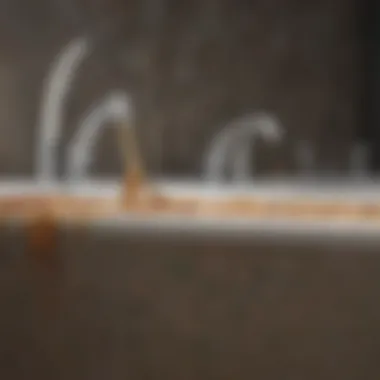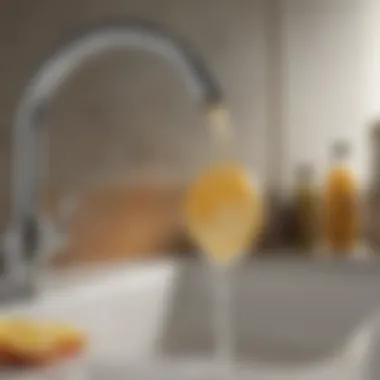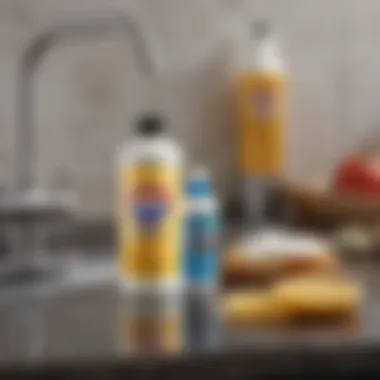Remove Calcium Deposits from Faucets Effectively


Intro
Calcium deposits are a common yet often overlooked issue in households. They form from hard water, which contains high levels of calcium and magnesium. Over time, these minerals accumulate on faucets, leading not only to unsightly stains but also to reduced water flow. Understanding how to effectively remove these deposits is crucial for maintaining the functionality and appearance of your faucets. In this article, we will explore the causes of calcium buildup, its implications if left untreated, and practical methods to tackle this problem.
Key Points
This article covers:
- The causes of calcium deposits: Understanding why they form.
- The implications of neglect: What happens if you ignore these deposits.
- Effective removal methods: Various approaches to clean faucets thoroughly.
- Practical tips: Strategies to prevent future buildup.
By addressing these key points, readers will gain valuable insights that can help sustain the longevity of their faucets.
Understanding Calcium Deposits
Calcium deposits are a common issue that many homeowners encounter, especially in areas with hard water. Understanding these deposits is crucial because they can affect both the functionality and appearance of faucets. When calcium accumulates, it can hinder water flow and create unsightly stains. Furthermore, being aware of how these deposits form and where they typically occur is essential for effective prevention and removal strategies.
Defining Calcium Deposits
Calcium deposits primarily stem from minerals found in hard water. When water evaporates, it leaves behind these minerals, predominantly calcium and magnesium, which form a thin, chalky buildup on faucet surfaces. This accumulation can appear as white or cloudy spots, often mistaken for dirt or grime. Understanding the nature of calcium deposits helps in recognizing that this is not just a cosmetic issue, but one that can lead to more significant plumbing problems if left unaddressed.
Formation of Calcium Buildup
The formation of calcium buildup occurs gradually. It begins when hard water flows through faucets, leaving behind mineral residues. Over time, repeated exposure to water increases these deposits. Environmental factors like temperature and humidity levels also play a role. In warmer climates, the rate of evaporation increases, thus heightening the concentration of mineral deposits left behind.
To summarize, calcium buildup occurs due to:
- Evaporation of water: Leaves minerals behind.
- Hard water content: Contains high levels of calcium and magnesium.
- Environmental conditions: Warmth and humidity can accelerate buildup.
Common Locations for Calcium Deposits
Recognizing where calcium deposits are most likely to form helps in taking proactive steps to clean and maintain faucets. Common locations include:
- Faucet aerators: The mesh screens can quickly accumulate deposits, causing reduced water flow.
- Showerheads: These are often exposed to water continuously, making them prime candidates for buildup.
- Around sink edges: Water splashes can lead to heavy deposits forming around the base and edges of sinks.
Recognizing the Symptoms of Calcium Accumulation
Understanding how to recognize the symptoms of calcium accumulation is essential for effective maintenance of your faucets. Early identification of these symptoms can save time and resources. Noticing the signs early allows for prompt action, preventing further buildup that may lead to more severe issues. This section highlights the visible signs of calcium deposits and the impact they can have on water flow, providing specifics that can help in effectively managing your faucets.
Visible Signs on Faucets
Calcium deposits often manifest as unsightly white or cloudy marks on the faucet surface. These marks are the most straightforward indicators of buildup. They can appear as patches or as a fine film, depending on the severity of the accumulation. In addition to aesthetic concerns, these signs may point to other underlying issues related to water hardness. It is vital to inspect faucets regularly, paying close attention to the aerator and spout. The accumulation may also extend to nearby surfaces.
- Chalky Residues: Commonly seen around faucet edges.
- Dull Finish: Faucets may lose their shine and look worn.
- Textured Surface: The buildup can lead to an uneven texture.
These signs are an indication that it's time to take action.
Impact on Water Flow
Calcium deposits not only affect the appearance of faucets but also their functionality. As deposits build up, they can restrict the flow of water. This restriction might cause uneven water pressure and reduced performance in failing to distribute water efficiently. For instance, if the aerator is clogged, the water may splash or flow erratically.
- Reduced Flow Rate: A noticeable reduction in water flow.
- Intermittent Pressure: Fluctuations in pressure can lead to knocks in pipes.
- Splashing Water: Insufficient flow may cause water to spray unintendedly.
Addressing these symptoms promptly can prevent irreversible damage to the faucet and ensure optimal water efficiency. Being observant of these indicators is crucial to maintaining not just the faucet but also the overall plumbing system.
Reasons to Remove Calcium Deposits
Removing calcium deposits from faucets is not just an aesthetic concern but a matter of functionality and efficiency. Understanding the importance of addressing these deposits helps maintain both the appearance and the working condition of faucets. There are three main reasons why this maintenance task should not be overlooked: preserving faucet longevity, maintaining water efficiency, and enhancing aesthetic appeal.


Preserving Faucet Longevity
Calcium buildup can lead to significant damage over time. When deposits accumulate, they can affect the way faucets operate. This buildup can lead to corrosion and wear, negatively impacting moving parts. If left untreated, it may result in costly repairs or even replacement of the faucet. Regular removal of these deposits helps in maintaining the integrity of the faucet components, thereby extending its lifespan.
- Cost-Effectiveness: Investing time in cleaning can save money in the long run by preventing major repairs.
- Operational Efficiency: A clean faucet operates without hindrance, reducing the stress on its mechanisms.
Maintaining Water Efficiency
Calcium deposits can obstruct flow, which affects water efficiency. When water flow is restricted by buildup, faucets have to work harder to deliver an adequate amount of water. This not only wastes water but can also increase utility bills. By removing calcium deposits, the faucet can function at optimal efficiency, saving both water and money.
"Efficient water flow is essential for sustainability and cost-saving in households."
- Environmental Impact: Reducing water waste contributes to more sustainable living.
- Lower Water Bills: Efficient faucets help in keeping monthly expenses in check.
Enhancing Aesthetic Appeal
The presence of visible calcium deposits can detract from the overall appearance of your kitchen or bathroom. A faucet adorned with mineral deposits appears neglected and unclean, diminishing the appeal of the entire space. Removing these deposits can restore the shine and polished look of faucets, contributing to a pleasing environment.
- Home Value: Well-maintained fixtures can increase the appeal of your home if you are considering selling it in the future.
- Positive Impression: A clean and functional faucet creates a better atmosphere in the home.
In summary, focusing on the removal of calcium deposits ensures that faucets remain functional, efficient, and visually appealing. The benefits from this simple maintenance task can lead to greater satisfaction with your home fixtures.
Approaches to Removing Calcium Deposits
Effectively removing calcium deposits from faucets requires a strategic approach. There are various methods available, each with its own merits. Understanding these approaches helps in selecting the most suitable one for your specific situation. The right method can make the cleaning process easier and more effective, leading to improved faucet functionality and aesthetics.
Using Vinegar and Water Solution
Vinegar is a natural acid that effectively dissolves calcium deposits. To use it, mix equal parts of white vinegar and water in a spray bottle. Spray the mixture onto the affected areas and let it sit for at least 30 minutes. This allows the acidity of the vinegar to break down the buildup. Afterward, wipe the faucet with a clean cloth. Rinse thoroughly with water to remove any remaining vinegar residue.
Employing Commercial Descalers
Commercial descalers are specifically manufactured to tackle mineral deposits like calcium. Before using any product, read the instructions carefully. Apply the descaler as directed, often wearing gloves for protection. These products usually require some time to penetrate and dissolve the deposits. After the recommended waiting period, scrub the faucet with a soft cloth or sponge and rinse well.
Scrubbing with Baking Soda Paste
Another effective method is using baking soda. Create a paste by mixing baking soda with a small amount of water until it has a thick consistency. Apply this paste to the affected areas, then scrub gently with a toothbrush or sponge. The mild abrasive nature of baking soda helps lift the deposits without scratching the faucet surface. Rinse the area afterward to ensure no residue remains.
Utilizing Lemon Juice for Natural Cleaning
Lemon juice is a natural alternative for those seeking a non-toxic option. It has citric acid which can help break down calcium deposits. Squeeze fresh lemon juice directly onto the affected areas, or soak a cloth in lemon juice and apply it. Let it sit for 20 to 30 minutes, then scrub lightly and rinse thoroughly. This method not only cleans but also leaves a fresh scent.
Using these methods regularly can prevent substantial buildup and maintain the overall appearance of your faucets.
Step-by-Step Cleaning Process
Addressing calcium deposits effectively requires a systematic approach. Each step in the cleaning process builds on the previous one, ensuring that you do not overlook essential details. Following a structured method provides clarity and increases efficiency. Engaging in a careful cleaning routine not only helps in easy removal of these deposits but also minimizes damage to your faucet and fixtures.
Preparation and Safety Measures
Before you initiate the cleaning, preparation is key. Gather all necessary tools and cleaning solutions. The right products will simplify the task. Here’s what you should have:
- Vinegar or a commercial descaler.
- Baking soda if you choose a paste option.
- A soft brush or cloth for scrubbing.
- Protective gloves to ensure skin safety.
- Safety glasses to shield your eyes from splashes.
Ensuring safety measures are in place is crucial. Both vinegar and commercial cleaners can irritate the skin and eyes. Thus, wearing gloves and glasses protects against any accidental exposure. Additionally, some cleaning agents can produce fumes. Adequate ventilation helps mitigate inhalation risks, so keep windows open or turn on exhaust fans.
Applying the Cleaning Solution


After gathering materials and ensuring safety, it is time to apply the cleaning solution. Depending on your choice of solution, dilute vinegar with equal parts of water for a homemade cleaner or follow the instructions on commercial descalers. Apply the solution directly to the affected areas of the faucet.
Use a spray bottle for exact application, ensuring even coverage. If opting for a paste approach using baking soda, mix it into a thick paste and apply it directly on stubborn spots. Allow the solution to sit for approximately 10 to 15 minutes. This duration enables the solution to penetrate and break down the calcium buildup more effectively.
Scrubbing the Affected Areas
With the solution in place, the next step involves scrubbing. Use a soft-bristled brush or cloth to scrub the areas where calcium deposits are visible. It is important to apply gentle, circular motions. This technique ensures that you do not scratch the finish of the faucet. For tighter spaces, a toothbrush can serve as a good substitute to reach corners and edges.
Make sure to scrub thoroughly to remove all visible deposits. If areas remain stubborn, apply more cleaning solution and repeat the scrubbing process. Consistency during this phase increases effectiveness, ensuring a more thorough clean.
Rinsing and Inspecting
Once you have scrubbed all affected areas, rinsing becomes crucial. Rinse your faucet with warm water to remove any cleaning solution residues. This step is important for several reasons. First, it eliminates any remaining chemicals that might cause irritation. Second, rinsing reveals any areas that might still have calcium buildup.
Inspect the faucet carefully after rinsing. If deposits still exist, it may be necessary to repeat the cleaning steps. A thorough inspection ensures the faucet remains functional and visually appealing. After confirming the success of your cleaning efforts, dry the faucet with a soft cloth to prevent new water spots or deposits from forming.
Remember: Regular cleaning helps prevent significant calcium buildup, making future maintenance easier.
Preventive Measures Against Calcium Buildup
Preventing calcium buildup in faucets is crucial for maintaining both functionality and aesthetic appeal. Calcium deposits not only impair water flow but also diminish the shine of faucets, giving them an unkempt appearance. Taking proactive steps to mitigate this issue can save time, effort, and resources in the long run. Implementing preventive measures ensures longer-lasting fixtures and less frequent need for harsh cleaning treatments.
Understanding Water Quality
Water quality is the first element to consider in preventing calcium deposits. Different regions have varying water hardness levels due to mineral content, particularly calcium and magnesium. Understanding if your water is hard or soft will guide your approach to managing deposits. Hard water generally leads to increased calcium buildup.
To determine your water hardness, consider using a simple water testing kit. If hard water is an issue, using a water softener can significantly reduce mineral content, thereby decreasing the chances of deposit formation.
Regular Maintenance Schedule
Establishing a regular maintenance schedule is effective in controlling calcium buildup. Cleaning faucets and their surrounding areas weekly can prevent accumulation of hard water minerals. Use a soft cloth with a gentle cleaning solution, which will help keep deposits at bay.
In addition, regular inspection of faucet aerators and showerheads can identify early signs of buildup. Removing and cleaning these components every month can go a long way. Addressing these small tasks prevents the need for more extensive and time-consuming cleaning later.
Installation of Water Softeners
Installing a water softener system is a long-term solution for dealing with hard water and the resulting calcium deposits. Water softeners remove or neutralize calcium and magnesium ions, effectively turning hard water into soft water. This significantly lessens the potential for mineral buildup in faucets and other household fixtures.
When considering a water softener, assess your home's water usage and the size of your plumbing system to ensure the unit is suitable for your needs. A properly installed and maintained water softener not only tackles calcium issues but can also improve the lifespan of plumbing.
Remember, prevention is simpler and often cheaper than remediation. By understanding water quality, adopting a maintenance schedule, and evaluating the need for a water softener, you can effectively mitigate the risks of calcium deposit buildup.
Choosing the Right Cleaning Products
When dealing with calcium deposits, selecting the appropriate cleaning products is paramount. The effectiveness of the cleaning process largely hinges on the agents used. A well-informed choice can lead to successful removal of buildup, safeguarding both functionality and visual appeal of faucets.
Types of Cleaning Agents
There are multiple cleaning agents available for removing calcium deposits. Each has its unique properties that cater to specific situations. The common types include:
- Vinegar: This acidic solution is effective in dissolving calcium due to its natural properties. It’s readily available and cost-effective.
- Commercial Descalers: Brands like CLR and Lime Away offer strong formulations specifically designed to combat mineral deposits. These are useful for stubborn cases.
- Baking Soda: Mixed with water, it forms a paste that can be applied directly on affected areas. Its gentle abrasive quality can aid in scrubbing without scratching.
- Lemon Juice: Acidity in lemon juice can help break down buildup, and it gives a fresh scent as a bonus.
Evaluating Product Effectiveness
While many products promise efficacy, evaluating their actual performance is crucial. Consider the following factors:
- Ingredient Transparency: Look for products with clear labeling. Knowing what’s inside can guide you to select safer options for both your home and the environment.
- User Reviews: Assess the experiences of other users. Online reviews can provide insights into effectiveness and ease of use.
- Target Specificity: Choose a cleaner that specifies its effectiveness against calcium. General cleaners may not do as well.


Environmental Considerations
Choosing cleaning products with environmental awareness is increasingly important. Here are some points to ponder:
- Biodegradability: Opt for products that break down naturally without leaving harmful residues.
- Chemical Composition: Avoid harsh chemicals that can dilute in water systems and harm aquatic life. Seek out green certifications or plant-based options.
- Packaging: Consider products in recyclable or minimal packaging to reduce waste.
"Making conscious decisions about cleaning products not only helps in maintaining faucets but also protects the environment."
In summary, the choice of cleaning products plays a significant role in effectively tackling calcium deposits. A thoughtful selection of the right agents can enhance the cleaning experience while being respectful of ecological concerns and personal health.
Common Mistakes to Avoid
Removing calcium deposits form faucets is not just about choosing a cleaning method; it also involves understanding and avoiding common mistakes that can hinder the process. By recognizing these blunders, one can ensure the efforts to clear calcium deposits are effective and sustainable.
Ignoring Prevention Strategies
One prevalent mistake is the tendency to ignore prevention strategies entirely. Individuals may think that once they clean the faucets, their problems with calcium deposits will vanish for good. However, overlooking preventive measures means that the deposits will return or even worsen. Simple actions like regularly checking water quality, using water softeners, and routine maintenance can greatly enhance faucet lifespan. These actions create a less hospitable environment for calcium buildup, allowing the faucet to function better over time.
Overusing Harsh Chemicals
Another significant mistake is the overuse of harsh chemicals. While many people believe that stronger chemicals yield better results, this is not always true. Excessive application of these substances can lead to damage of the faucet finish. Additionally, harmful chemicals can cause adverse reactions with the residue from previous cleanings. It is critical to use cleaning agents with caution and to adhere to the specific guidelines for each product to avoid damaging the surface or the functionality of the faucet.
Neglecting Regular Cleaning
Neglecting a regular cleaning schedule is also a frequent error. Some people may be aware of calcium buildup but fail to act promptly. Allowing deposits to accumulate over time leads to more challenging clean-up efforts, necessitating harsher methods that can damage the faucet. Regular cleaning prevents serious buildup and keeps faucets looking pristine. Setting a periodic schedule for maintenance, ideally once every few weeks, will keep these issues manageable.
Key Takeaway: Avoiding these mistakes leads to a more effective and sustainable approach to managing calcium deposits, ultimately preserving the functional and aesthetic qualities of your faucets.
The Importance of Professional Help
Addressing calcium deposits from faucets often appears as an at-home task. While many cleaning methods are effective for minor build-up, some cases necessitate professional intervention. Calling a professional can offer several advantages. Not only do they have the right tools for the job, but their expertise can save time and ensure effective results.
When to Call a Professional
There are certain situations when it may be best to seek assistance from experts. If calcium deposits are extensive or have been present for a long time, a DIY approach might not yield satisfactory results. A professional can quickly assess the level of damage and provide a tailored approach.
When moving water flow becomes restricted or leaks develop due to build-up, it is crucial to act fast. A technician can identify underlying issues, preventing further complications. Moreover, if the deposits involve intricate faucet designs or hard-to-reach areas, professional tools and techniques can deliver superior cleaning.
Benefits of Expert Services
Engaging expert services for removing calcium deposits comes with several benefits. First, professionals bring specialized knowledge in various cleaning techniques that cater to unique situations. They also use high-grade cleansers and equipment that are often not available to the average consumer.
Additionally, benefits include:
- Safety: Professionals know how to handle hazardous chemicals, reducing risks associated with improper use.
- Time Efficiency: They can complete the job in a fraction of the time it would take a homeowner.
- Long-Term Solutions: Experts can provide guidance on maintaining faucets after treatment, which can help in prevention of future build-up.
Ultimately, while cleaning calcium deposits might seem straightforward, the importance of professional help cannot be overstated. Aiming for efficiency and safety ensures the longevity of both the faucet and plumbing system.
Finale
In summary, effectively removing calcium deposits from faucets is crucial for maintaining both practicality and aesthetics in your kitchen or bathroom. These deposits, primarily calcium carbonate, can not only affect the functionality of your faucets by obstructing water flow but can also detract from the overall appearance of your fixtures. The systematic cleaning routines and preventive measures discussed throughout this article highlight the importance of regular maintenance. This ensures that those unsuspecting calcifications do not transform into more significant issues, leading to costly repairs or replacements.
The benefits of addressing calcium buildup promptly are multifaceted. By preserving the longevity of your faucet, maintaining optimal water efficiency, and enhancing the visual aspects of your fixtures, you invest in the durability of your plumbing system. Adapting a proactive approach can provide long-term solutions, alleviate future headaches, and save resources. Therefore, the concluding message of this article is this: taking the time to understand, recognize, and actively combat calcium deposits will lead to overall improved functionality and aesthetics in your home.
Summary of Key Points
- Understanding Calcium Deposits: Recognizing what calcium deposits are and how they form is essential for effective removal.
- Symptoms of Accumulated Deposits: A visible inspection of faucets can reveal signs of calcium buildup, which may inhibit water flow.
- Methods for Removal: From vinegar solutions to commercial descalers, multiple approaches can be employed for effective cleaning.
- Preventive Measures: Regular maintenance and the potential use of water softeners can reduce the risk of future deposits.
Final Recommendations
- Routine Inspection: Regularly check your faucets for any signs of accumulation to catch problems early.
- Use Natural Solutions: Whenever possible, opt for natural cleaning agents like vinegar or lemon juice, which can be just as effective without the harshness of industrial chemicals.
- Stay Informed: Understanding your local water quality can provide insights into the hardness of your water, helping you anticipate and manage deposits effectively.
- Avoid Harsh Chemicals: Use cleaning products and methods that are safe for your faucet material to prevent damage.
- Engage Professionals When Needed: If the deposits are extensive or persistent, do not hesitate to seek professional help for a comprehensive solution.
Remember: Regular attention to your faucets can keep your plumbing system running smoothly and maintain your home’s aesthetic appeal.















